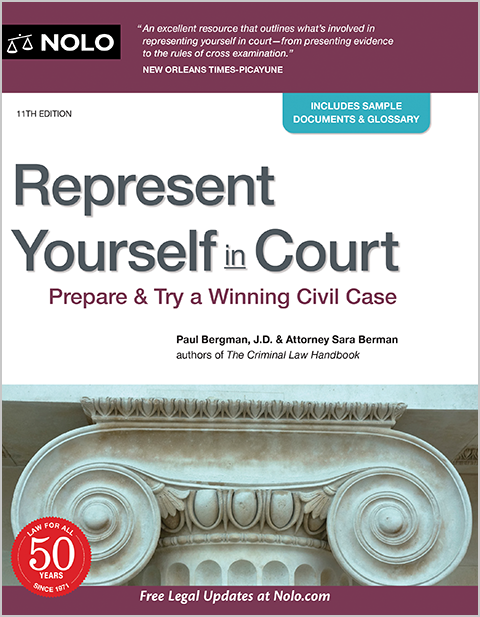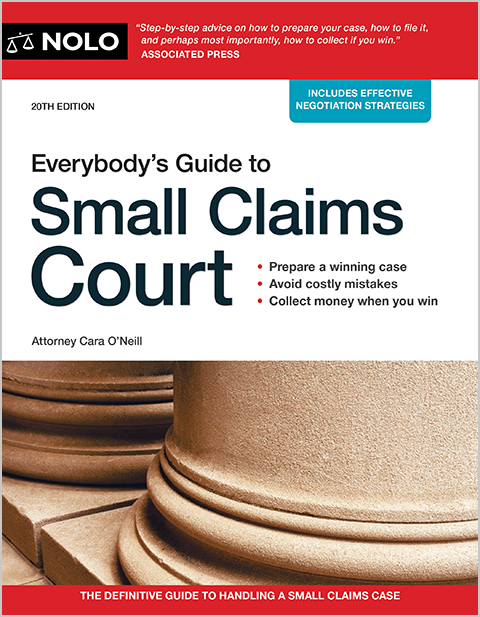A look at the personal injury cases you can, can't, and shouldn't file in small claims court.
Can you file a personal injury (PI) lawsuit in your state's small claims court? The answer is: With a few exceptions, yes.
Rhode Island, for example, bars small claims suits for personal injuries, negligence, and property damage. Minnesota doesn't permit defamation or medical malpractice lawsuits in small claims court. But those exceptions (and a few others) aside, you're free to bring a small claims action for personal injury damages, as long as the amount you're asking for is within the court's jurisdictional limit.
The fact that you can bring a PI small claims lawsuit doesn't mean that you should. Some types of PI cases—we'll explain what they are—are a good small claims fit. Others? Not so much. As a general rule, if the facts are complicated, the legal issues are complex, the case will be expert witness heavy, or your damages will be a challenge to prove, you belong in regular court (represented by counsel), not small claims court. We'll walk you through a couple of those cases, too.
What Counts as a Personal Injury Case?
There's no single, generally accepted definition for "personal injury cases." The term is sort of a catch-all, encompassing a variety of case types that share common damage categories. In other words, what makes a PI case a PI case isn't so much the type of case it is, but the types of damages it involves.
More specifically, cases falling under the PI rubric all involve some kind of harm—physical, mental, emotional, or reputational—to a natural person. Here are some of the most common examples:
- physical harm to the body or its organs
- pain and suffering
- emotional distress
- disability and disfigurement
- lost wages, income, earning capacity, or benefits
- loss of society, companionship, or consortium
- loss of standing or reputation in the community, and
- loss of enjoyment of life.
Injuries and harms like these are likely to show up in lots of different kinds of cases, such as:
- car wrecks
- slip and fall and premises liability
- dangerous products
- defamation
- medical malpractice
- assault and battery, and
- false arrest and false imprisonment.
Most of these case types are grounded in negligence law but a few—assault and battery, false arrest, false imprisonment, and some defamation cases—are what the law calls "intentional torts." In states where you can file small claims PI cases, both negligence and intentional tort lawsuits are allowed.
There's another group of cases that have the look and feel of PI lawsuits, though technically they're different. Wrongful death and civil rights claims are statutory, meaning they're based either on federal or state statutes. There's likely to be considerable overlap between PI damages, wrongful death damages, and civil rights statutory damages.
Personal Injury Cases That Are a Good Small Claims Fit
The key to a successful small claims fit isn't case type, it's simplicity. That, by itself, is enough to make some cases (discussed below) poor candidates for small claims court.
When you have one of the cases we discuss in this section, you might think about filing in your state's small claims court.
Minor Car Accident
Minor fender benders, where liability (legal responsibility) for the wreck is fairly clear and your injuries are simple and undisputed, are almost the prototype of an ideal small claims case.
Proving Liability. Your own testimony—perhaps bolstered by a witness, a copy of the police report, and some photos or videos of the scene and the involved vehicles—should be enough to prove who was at fault.
Proving Damages. Proof of your damages can be covered with:
- copies of your medical records and bills
- a letter from your employer's human relations office documenting your lost wages
- photos or video of your injuries, and
- a letter from your doctor describing your medical care and treatment.
If you also want to recover for the damage to your car, present the judge with a written estimate or two or, if you've had the repairs done, an actual repair bill. You should also have pictures of the damage you can show the court.
Watch Out for These Issues. Think twice about small claims court when any of these are issues in your car accident case.
- Your own fault. When the other side claims that you were also at fault—what the law calls comparative or contributory fault—you might be prohibited from collecting any damages for your injuries. You'll need help from experienced legal counsel to navigate that minefield.
- Causation. To collect money for your injuries, you must prove they were caused by the other driver's negligence. Causation normally isn't an issue in PI cases, but when it is, it can be a stone cold claim killer. This might be a problem when, for example, you have preexisting injuries to the same body parts that were injured in the accident. Should causation be a live issue in your case, you'll want help from an attorney.
- Future damages. Small claims court is ideal when you've made a full recovery from whatever minor injuries you suffered. When those injuries persist and are likely to need future treatment, proving future damages can be challenging. Here too, you should think about getting counsel on board.
Slip and Fall
Many people believe—mistakenly—that slip and fall cases are easy to win. Not so. Given the right facts, a slip and fall case can be a good small claims candidate, but thorny legal issues can quickly derail the case. You can learn more about your state's slip-and-fall laws.
Proving Liability. To show that a property owner or occupier is on the hook for your slip and fall, you'll need to prove these elements:
- there was a dangerous condition—maybe an icy parking lot or sidewalk, or a liquid or other slippery substance on the floor
- the property owner or occupant knew or should have known about the danger
- they had a reasonable opportunity to fix or warn of the dangerous condition, but failed to do so
- you exercised reasonable care for your own safety, and
- you were injured because of the dangerous condition.
Your testimony, along with that of others—especially people who encountered the dangerous condition before you did, or who saw you fall—will prove these elements. You'll also want to show the court photos of the dangerous condition and, if you have one, an incident report describing the condition.
Proof that the owner or occupier knew or should have known about the danger in time to act on it will be critical. Expect them to deny any knowledge, or to claim that they didn't have time to fix the condition, place warning signs, or take other safety precautions.
Proving Damages. You'll prove your damages in the same ways discussed above under "Minor Car Accident."
Watch Out for These Issues. Watch for the issues mentioned above under "Minor Car Accident."
- Knowledge of the danger. In addition, pay close attention to problems of proof concerning the existence of the danger. When slip and fall claims fail, it's often because the owner or occupier convinced the court that the danger hadn't been there long enough for them to discover it, or to take steps to fix or warn about it. Be ready with witness testimony or other evidence showing that the danger was there well before you encountered it, and that the owner or occupier had enough time to fix it or place warnings.
Assault and Battery
Technically, assault and battery are distinct wrongful acts, but they often travel as a pair. When someone intentionally acts in a way that causes you to reasonably fear imminent harmful or offensive contact, you've been assaulted. If they follow through and actually make contact that's harmful or offensive, the law calls that a battery.
The classic example involves someone who raises a fist to strike you. As long as you're aware of this conduct—and it reasonably causes you to fear getting hit—that's an assault. If they take a swing and punch you in the nose, you've been battered.
Proving Liability. Minor assault and battery cases often are good small claims candidates, because they tend to follow a familiar pattern: Each side claims they were acting in self defense, and that the other side was the aggressor. Figuring out who wins (if anyone) generally comes down to sorting out this attacker-defender argument.
You and your witnesses will testify regarding liability. Focus on showing that your opponent was moving forward, trying to engage or attack, while you tried to flee or talk your way out of a fight. When you have cellphone video of what happened, be sure to provide that to the judge.
If police responded and prepared a report that paints you in a favorable light, have a copy ready for the court. Similarly, if the other side was criminally charged and was convicted or pled guilty, you'll want to share that judgment transcript with the small claims judge hearing your case.
Proving Damages. Once again, you'll prove your damages as discussed under "Minor Car Accident," above.
Watch Out for These Issues. These issues might jeopardize your ability to win an assault and battery case in small claims court, or to collect any judgment you get.
- Self defense. As mentioned above, there's a good chance you'll encounter this defense. The other side will claim you were the aggressor—physically or verbally—and that they were simply defending themselves. Counter this with testimony that you tried to retreat, urged calm, or took other steps to avoid a fight. Should the other side succeed with a self-defense claim, you might leave court owing them money. Or the court might decide that it's impossible to sort out and send both sides home with nothing.
- Can you collect? Because assault and battery are intentional torts, they're almost certainly not covered by liability insurance. In other words, you'll have to figure out how to collect any small claims judgment you're awarded. When the defendant is judgment proof, meaning without insurance or other assets you can seize to collect what you're owed, there's probably little point throwing good money after bad, even in small claims court.
Defamation
When someone makes a false statement of fact about you that harms your reputation, you might have a defamation claim. As long as you're not a public official or public figure—the standard of proof for them is very high—think about filing your case in small claims court.
Proving Liability. You'll need to prove that someone made a false statement of fact about you—oral or written—that caused you some injury. Start by showing the court the statement(s) you claim were defamatory. Keep in mind that they must be statements of fact. Opinions, parody, and hyperbole won't count. As long as you're not a public official or public figure, all you need to show is that the defendant acted negligently.
Proving Damages. Most often, your defamation damages will be based on a reputational or emotional injury. That is, you'll need to prove the defamatory statements harmed your reputation or standing in the community, or caused you to suffer significant, unusual emotional distress.
It's not enough simply to argue that the statements were hurtful and made you mad. Did you lose a promotion at work? Get kicked out of your tennis foursome at the country club? Lose out on business opportunities? For the court to award defamation damages, you have to reduce them to dollars and cents.
Watch Out for These Issues. Be ready to deal with these issues in a defamation lawsuit.
- Not statements of fact. The defendant will try to argue that the offending statements were opinions, or otherwise weren't factual. Remember that facts can be proven true or false, and can be objectively verified or disproved. Opinions are based on feelings or beliefs, which can't easily be reduced to true or false. Simply prefacing a statement of fact with "It's my opinion" or "I believe that" won't magically transform it into opinion.
- The statements are true. As a rule, truth is a complete defense to defamation liability. When you're caught stealing and someone calls you a "thief," you don't have a viable defamation claim.
- Proving damages can be difficult. As mentioned above, it can be hard to quantify your defamation losses. How much is reputational harm or emotional distress worth? Note, too, that when you introduce evidence of your good reputation and character, you open the door for the other side to respond. Depending on the amount that's at stake, you could find it worthwhile to buy an hour or two of time with an experienced defamation lawyer to plan your damages presentation.
Personal Injury Cases That Don't Belong in Small Claims Court
Some PI cases simply don't belong anywhere near small claims court. They're too factually complicated, or they involve complex legal issues. Claims that rely heavily on expert witnesses or that will involve intricate scientific, medical, or technical evidence will quickly overwhelm small claims court resources.
When your case will require substantial formal pretrial investigation—called discovery—small claims court isn't for you. In many states, discovery isn't even allowed in small claims cases.
What kinds of claims are we speaking of? Here are a couple of examples.
Medical Malpractice Cases
Medical malpractice cases check nearly every small claims "no" box. They're factually and legally complex. You'll have to navigate special procedural rules designed to make malpractice cases harder to file and win. In nearly every case, you'll need one or more experts, who will testify to the medical standard of care, how your care was substandard, causation, and maybe damages.
Extensive discovery will be needed to prepare a medical malpractice case for trial. Finally, a medical malpractice case that involves damages small enough to recover in small claims court probably isn't worth pursuing, because you'll spend far more preparing the case than what it's worth.
Long story short: If you have a medical malpractice case worth filing, it belongs in regular—not small claims—court.
Product Liability Cases
When you've been injured by a dangerous product, you can file what's known as a "product liability" lawsuit. But like medical malpractice claims, suits over harmful products are a hard "no" for small claims court. They involve a special theory of legal responsibility called "strict liability," and almost without fail, they're legal and factual minefields.
Here too, you'll have to hire experts to testify about issues like design, manufacturing, dangerous and defective conditions, product warnings, and more. Given the costs involved and other factors, it doesn't make financial sense to pursue a product liability case in small claims court.
Next Steps
So, you've decided to file a PI claim in small claims court. What comes next? Start by learning about your state's small claims courts and how they work. Also, be sure you're familiar with the PI statute of limitations—the deadline to file a personal injury lawsuit in court. Miss that time limit and you lose the right to get compensation for your injuries, in small claims (or any other) court in your state.
Chances are you can't simply pick any small claims court in the state and sue there. The state's venue rules dictate where you can (and can't) file your lawsuit. Here's how you name the parties you're suing, and some pointers for how to organize and present your evidence to the judge. Find out what to expect during your hearing in small claims court.
Things didn't go your way? Learn about small claims appeals and what's involved.
Finally, there's no such thing as a "simple" lawsuit when you're the one who has to present it in court. If you're concerned or anxious about your case, think about asking a lawyer for guidance. It probably won't take much to get you squared away—an hour or two should suffice—and your investment might pay dividends if you impress the judge with an organized, clear, persuasive case presentation.



